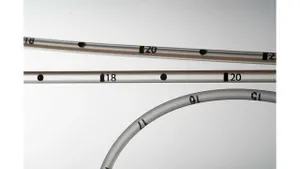How 3D printing is saving lives . . . again
You may remember an article we published in May 2013 about a 3D-printed tracheal splint that saved a baby's life. Dr. Glenn Green from the University of Michigan and biomedical engineer Scott Hollister from the university's 3D printing lab, who designed and fabricated that device, are back in the news.
March 19, 2014
You may remember an article we published in May 2013 about a 3D-printed tracheal splint that saved a baby's life. Dr. Glenn Green from the University of Michigan and biomedical engineer Scott Hollister from the university's 3D printing lab, who designed and fabricated that device, are back in the news. This time they came to the rescue of a baby with a defective windpipe that has spent the first 18 months of his life in a hospital bed tethered to a ventilator.
Garrett Peterson was born with tracheomalacia, which left his trachea weak and vulnerable to collapse. Even during a diaper change, "he would turn completely blue," says his mother in a press release posted on the University of Michigan website.
Because of his condition, Garrett could not leave the hospital, where he was hooked up to a ventilator set at maximum pressure. He was frequently given strong medication and had even been put into a medically induced coma to prevent him from wrestling with the ventilator. The Petersons read about how Hollister and Green had saved the life of one baby, who recently celebrated his second birthday and lives a perfectly normal and healthy life. The decision was made at the end of 2013 to leave Utah, where they reside, and head for Michigan.
Hollister created a 3D model of Garrett's airway and custom splints that would fit on his bronchi. The 3D-printed devices are made from polycaprolactone, a bioresorable material that dissolves into the body in two to three years, roughly the amount of time it takes for the trachea to return to a normal state. Hollister received emergency clearance from FDA to implant the splint, and surgery was performed on Jan. 31, 2014.
When Richard G. Ohye, MD, head of pediatric cardiovascular surgery at the University of Michigan C.S. Mott Children's Hospital, opened Garrett's chest, he saw that his windpipe had collapsed and that one of his lungs was completely white. The only time he had seen a lung in that condition was in a dead person, reports NPR. Ohye sewed the splints around Garrett's right and left bronchi to expand the airway and give it support to aid proper growth. Following the procedure, the mood turned tense, as the surgeon let air flow through Garrett's windpipe into his lungs. The windpipe stayed open, and his white lung turned a healthy pink.
"That was just amazing to me," Green told NPR. "Here's something that we had worked on, that had been constructed just a week ago to match this defect. It worked just the way we had hoped. I said, 'this is going to change this boy's life and his family's life forever."
Although Garrett is still in the hospital, he is gaining strength by the day. His parents are looking forward to bringing him home for the first time very soon.
The video below shows how the devices are 3D printed at the University of Michigan.
About the Author(s)
You May Also Like




